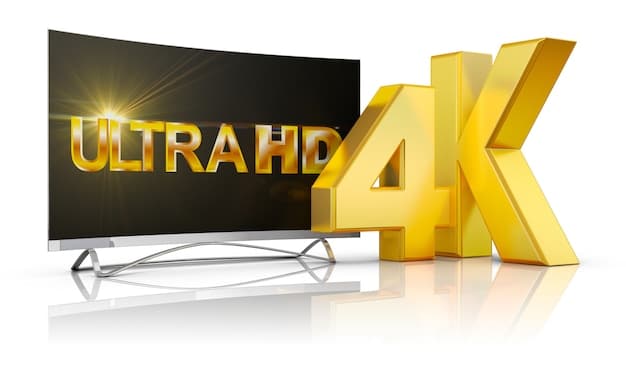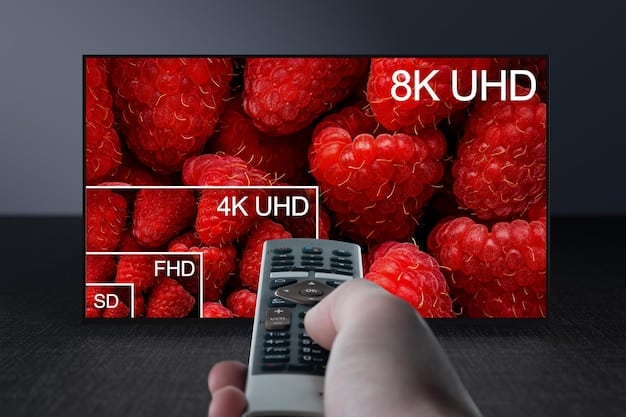The Ultimate Guide to 4K Streaming in the US: Devices, Services, and Requirements

4K streaming in the US offers a visually stunning experience, but requires compatible devices, the right streaming services, and sufficient bandwidth to enjoy high-resolution content seamlessly; this guide explores all aspects necessary for optimal 4K streaming.
Ready to dive into the world of crystal-clear visuals? The Ultimate Guide to 4K Streaming in the US: Devices, Services, and Bandwidth Requirements provides everything you need to know to enjoy your favorite shows and movies in breathtaking 4K resolution.
Understanding 4K Streaming
4K streaming has revolutionized home entertainment, offering four times the resolution of standard HD. This means sharper images, more vibrant colors, and an overall more immersive viewing experience. However, understanding the technology and requirements is crucial to fully enjoy 4K content.
What is 4K Resolution?
4K resolution, also known as Ultra HD (UHD), has a horizontal resolution of approximately 4,000 pixels. The most common 4K resolution is 3840 x 2160 pixels, providing a significant upgrade in picture quality compared to 1920 x 1080 (Full HD).
Benefits of 4K Streaming
The primary benefit of 4K streaming is the enhanced visual quality. This includes:
- Increased detail and clarity in images.
- More vibrant and accurate colors.
- A more immersive and engaging viewing experience.
- Improved contrast, making dark scenes clearer.
By grasping the fundamentals of 4K streaming, viewers can better prepare to optimize their setup for superior picture quality.

Essential Devices for 4K Streaming
To access and enjoy 4K content, it’s essential to have the right devices. These devices must support 4K resolution and high-speed data transfer to ensure smooth streaming.
4K Televisions
The core of any 4K streaming setup is a 4K-compatible television. Look for TVs that specifically advertise 4K or Ultra HD support. Ensure the TV has HDMI 2.0 or later ports, which are needed to transmit 4K content at 60 frames per second (fps).
Streaming Devices
Many streaming devices support 4K resolution, including:
- Roku: Offers a range of 4K-compatible devices like the Roku Streaming Stick+ and Roku Ultra.
- Amazon Fire TV: Provides 4K streaming options such as the Fire TV Stick 4K and Fire TV Cube.
- Apple TV 4K: Delivers high-quality 4K streaming and integrates seamlessly with the Apple ecosystem.
- Nvidia Shield TV: An Android-based option that supports 4K HDR streaming and gaming.
Gaming Consoles
Modern gaming consoles can also stream 4K content, including:
- PlayStation 5: Supports 4K streaming from various services.
- Xbox Series X/S: Offers 4K streaming capabilities and Blu-ray playback.
With the right devices in place, you’re well on your way to enjoying stunning 4K visuals.
Top 4K Streaming Services in the US
Several streaming services offer content in 4K resolution, each with its unique library and subscription model. Choosing the right service depends on your viewing preferences and budget.
Netflix
Netflix is a leading streaming service with a vast library of 4K content, including original series, movies, and documentaries. A premium subscription is required to access 4K content.
Amazon Prime Video
Amazon Prime Video offers a wide selection of 4K movies and TV shows, often included with an Amazon Prime subscription. Some titles are available to rent or purchase in 4K.
Disney+
Disney+ provides a growing library of 4K content, including Marvel, Star Wars, Pixar, and National Geographic titles. The service supports Dolby Vision and Dolby Atmos for enhanced visual and audio quality.

Hulu
Hulu offers select 4K content, mainly available through its on-demand library. Check specific titles to confirm 4K availability, as not all content is offered in Ultra HD.
Selecting the right streaming service with a robust 4K library unlocks a world of high-resolution entertainment.
Understanding Bandwidth Requirements
4K streaming demands a significant amount of bandwidth to deliver smooth, buffer-free video. Meeting these bandwidth requirements is crucial to prevent interruptions and maintain high picture quality.
Minimum Bandwidth Recommendations
Most streaming services recommend a minimum download speed of 25 Mbps for 4K streaming. However, for optimal performance, a speed of 50 Mbps or higher is often preferable.
Factors Affecting Bandwidth
Several factors can impact your available bandwidth, including:
- The number of devices using the internet connection simultaneously.
- The type of internet connection (e.g., cable, fiber, DSL).
- The distance from your home to the internet service provider’s equipment.
Testing Your Internet Speed
To ensure you meet the bandwidth requirements, perform a speed test using online tools such as Speedtest by Ookla or Fast.com. This will provide insights into your download and upload speeds.
Adequate bandwidth is the backbone of seamless 4K streaming, ensuring you enjoy your content without interruptions.
Optimizing Your 4K Streaming Setup
Beyond the right devices and bandwidth, several optimizations can enhance your 4K streaming experience. These include adjusting video settings, ensuring proper cabling, and optimizing your network.
Adjusting Video Settings
Most streaming devices and smart TVs allow you to adjust video settings. Ensure that your device is set to output video in 4K resolution. Enable HDR (High Dynamic Range) if your TV and content support it for enhanced color and contrast.
Using the Right Cables
Use high-quality HDMI cables that support HDMI 2.0 or later to transmit 4K content at 60fps. Poor-quality cables can result in signal degradation or an inability to display 4K content correctly.
Optimizing Your Network
Consider the following network optimizations:
- Use a wired Ethernet connection instead of Wi-Fi for more stable and reliable bandwidth.
- Upgrade your router to a newer model that supports 802.11ac or 802.11ax (Wi-Fi 6) for improved wireless performance.
- Position your router in a central location to ensure optimal signal coverage throughout your home.
By implementing these optimizations, you can fine-tune your streaming setup for the best possible picture quality and performance.
Troubleshooting Common 4K Streaming Issues
Even with the right setup, you may encounter occasional issues with 4K streaming. Understanding how to troubleshoot these problems can help you quickly resolve them and get back to enjoying your content.
Buffering Issues
Buffering is a common problem that can disrupt your viewing experience. Try the following solutions:
- Pause the stream for a few minutes to allow the content to buffer.
- Close other applications or devices that are using bandwidth.
- Restart your modem and router.
- Contact your internet service provider to check for network issues.
Picture Quality Problems
If the picture quality is not as expected, consider these steps:
- Verify that your streaming device and TV are set to output 4K resolution.
- Ensure that you are using a high-quality HDMI cable.
- Check your streaming service subscription to ensure it supports 4K content.
Compatibility Issues
Sometimes, devices may not be fully compatible. Check if there are any firmware updates available for your TV or streaming device. Contact the manufacturer’s support if the problem persists.
Equipped with these troubleshooting tips, you can tackle common 4K streaming issues and maintain a smooth viewing experience.
| Key Point | Brief Description |
|---|---|
| 📺 4K Devices | Use a 4K TV and streaming device like Roku, Fire TV, or Apple TV. |
| 🎬 Streaming Services | Netflix, Amazon Prime, Disney+, and Hulu offer 4K content. |
| 🌐 Bandwidth | Minimum of 25 Mbps, but 50 Mbps or higher recommended for smooth 4K streaming. |
| ⚙️ Optimization | Adjust video settings, use high-quality HDMI cables, and optimize your network for better performance. |
FAQ
▼
4K and Ultra HD (UHD) are often used interchangeably. While true 4K resolution is 4096 x 2160 pixels, UHD is commonly 3840 x 2160 pixels. For consumer products like TVs and streaming, UHD is generally what’s being referred to.
▼
4K streaming can consume a significant amount of data, typically around 7GB to 10GB per hour. Actual usage depends on the streaming service and video quality settings. Monitor your data usage if you have a limited data plan.
▼
Yes, you can stream 4K over Wi-Fi, but a stable and strong connection is essential. For optimal performance, consider using a 5 GHz Wi-Fi band and ensure your router is close to your streaming device. A wired Ethernet connection is often more reliable.
▼
HDR (High Dynamic Range) enhances the color and contrast of video content, making the viewing experience more realistic and immersive. When streaming 4K content, HDR can significantly improve the picture quality, offering a broader range of colors and brighter highlights.
▼
A blurry 4K stream can result from insufficient bandwidth, incorrect video settings, or issues with the streaming service’s encoding. Check your internet speed, verify your device’s output settings, and ensure the streaming service is delivering the content in 4K resolution.
Conclusion
Navigating the landscape of 4K streaming in the US requires understanding the essential components: compatible devices, suitable streaming services, and adequate bandwidth. By optimizing your setup and troubleshooting common issues, you can unlock the full potential of 4K resolution and enjoy a truly immersive viewing experience.





